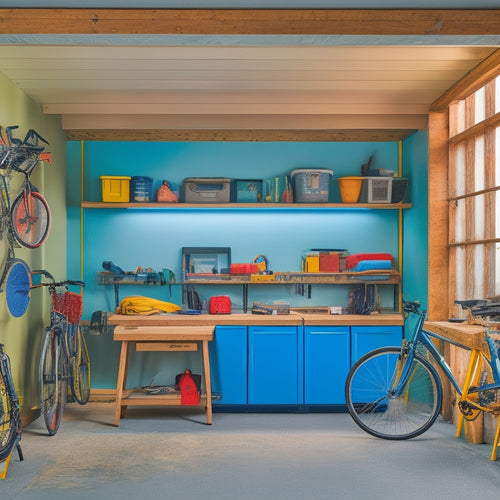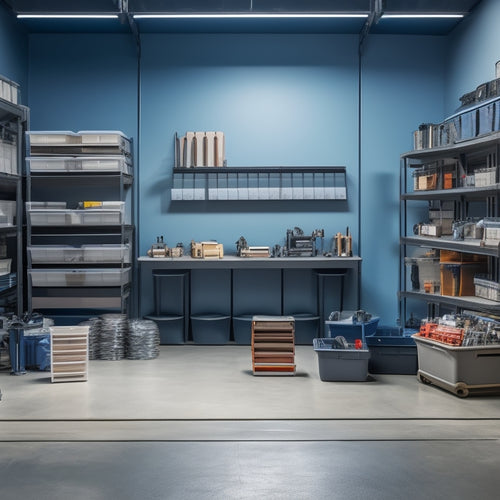
Tool Storage Containers for Organization and Efficiency
Share
You're losing precious time and money due to disorganization, but the right tool storage containers can revolutionize your workspace. Mobile toolboxes, portable tool cases, wall-mounted organizers, tool chests, and storage bins cater to different tool types and work environments. To choose the perfect fit, measure tool dimensions, calculate storage capacity, and consider adjustable dividers and material durability. By selecting the ideal container, you'll reduce tool loss, prevent accidents, and enhance efficiency. Now that you've got a solid foundation, it's time to investigate the additional features and best practices that'll take your tool storage to the next level.
Key Takeaways
- Organized tool storage enhances productivity and efficiency by reducing search time and minimizing frustration on job sites.
- Choosing the right container size involves measuring tool dimensions, calculating total volume, and considering adjustable dividers for optimal storage.
- Durable materials like metal, plastic, and impact-resistant polypropylene ensure tool protection and longevity in various environmental conditions.
- Features like locking mechanisms, waterproofing, and customizable compartments provide added security, protection, and organization for tools.
- Proper labeling and signage, including color coding and clear font selection, facilitate quick tool identification and retrieval, reducing accidents and increasing efficiency.
Benefits of Organized Tool Storage
Having a well-organized tool storage system in place can greatly impact your productivity and efficiency on the job site. With a system that allows for easy tool accessibility, you'll spend less time searching for the right tool and more time getting the job done. This, in turn, reduces the risk of accidents and injuries caused by fatigue or frustration.
A well-organized system also enables effective inventory management. You'll be able to track which tools are in stock, which need to be replaced, and which can be repaired. This guarantees that you have the right tools when you need them, reducing downtime and increasing your overall efficiency.
Moreover, a well-organized tool storage system helps prevent tool loss and theft. When tools are properly stored and accounted for, you can identify missing items quickly and take action to recover them. This not only saves you money but also reduces the risk of accidents caused by using the wrong or damaged tools.
Types of Tool Storage Containers
You've recognized the importance of a well-organized tool storage system, and now it's time to investigate the various types of tool storage containers that can help you achieve this goal.
With so many toolbox styles and storage solutions available, it's crucial to choose the right one for your specific needs.
When it comes to selecting a tool storage container, consider the following options:
-
Mobile Toolboxes: These containers are mounted on wheels, allowing you to easily move them around the job site or workshop. They're ideal for large, heavy tools and equipment.
-
Portable Tool Cases: These compact containers are designed for smaller tools and accessories, making them perfect for on-the-go projects.
-
Wall-Mounted Tool Organizers: These space-saving solutions are great for small workshops or garages, keeping your tools organized and within easy reach.
Choosing the Right Container Size
You'll need to take into account two key factors when choosing the right container size: the range of container size options available, and the exact dimensions of the tools you need to store.
Measuring your tools' lengths, widths, and heights will help you narrow down the selection. By matching your tool dimensions to the container's internal dimensions, you'll guarantee a snug, organized fit.
Container Size Options
When organizing your tools, selecting the right container size is crucial to maximize storage efficiency and accessibility.
You want to make certain that your tools fit comfortably inside the container without overcrowding, which can lead to damage or accidents.
To choose the right container size, consider the following factors:
-
Container dimensions: Measure the length, width, and height of the tools you plan to store. This will help you determine the minimum container size required.
-
Storage capacity: Calculate the total volume of the tools you need to store. This will help you decide on the best container size for your tool collection.
-
Tool size variation: If you have tools of varying sizes, consider a container with adjustable dividers or compartments to accommodate different tool sizes.
Measuring Tool Dimensions
Measuring Tool Dimensions
Most tools have unique dimensions that require precise measurement to guarantee a proper fit in a storage container. You'll need to take exact measurements to make certain your tools fit snugly and safely in their designated containers.
To measure your tool dimensions accurately, use a ruler or caliper to record the length, width, and height of each tool. Take note of any protrusions, handles, or other features that may affect the tool's fit in the container.
When measuring, consider the tool's orientation in the container. Will it be stored vertically, horizontally, or at an angle? This will help you determine the best container size and layout.
Use precise measuring techniques to record the dimensions in inches or millimeters. Don't rely on estimates or rough guesses, as this can lead to poor container fit and decreased safety.
Material Options for Durability
When selecting a tool storage container, you'll want to contemplate the durability of the material.
Metal containers, for instance, offer strength and resistance to corrosion, but their durability depends on factors like gauge thickness and coating.
Meanwhile, plastic containers provide a range of strength options, from lightweight and flexible to heavy-duty and impact-resistant.
Metal Durability Factors
You're likely familiar with the importance of durability when it comes to tool storage containers. Metal containers, in particular, offer a high level of durability, making them a popular choice among professionals and DIYers alike.
When selecting a metal tool storage container, there are several factors to evaluate to guarantee you get the right one for your needs.
-
Rust resistance and corrosion prevention: Look for containers with a protective coating or finish, such as powder coating or zinc plating, to prevent rust and corrosion.
-
Weight capacity and impact resistance: Choose a container that can withstand the weight of your tools and equipment, and contemplate ones with reinforced edges and corners for added impact resistance.
-
Maintenance tips and metal finishes: Reflect on the maintenance requirements of the container, such as cleaning and lubricating hinges, and opt for a finish that suits your environment, such as stainless steel for high-humidity areas.
Plastic Strength Options
Beyond metal containers, plastic tool storage containers offer a durable and versatile alternative. When choosing a plastic tool storage container, you'll want to take into account the plastic thickness, as it directly affects the container's strength and durability. Thicker plastics can withstand more weight and impact, making them ideal for heavy-duty tools and equipment.
Impact resistance is another essential factor to take into account. Look for containers with high-impact resistant materials, such as polypropylene or polyethylene, which can absorb shocks and drops without cracking or breaking. This feature is particularly important if you plan to store heavy or sharp tools, as it guarantees the container can protect its contents and prevent damage.
Additionally, take into account the type of plastic used in the container's construction. For example, high-density polyethylene (HDPE) is a popular choice for tool storage containers due to its exceptional strength, durability, and resistance to corrosion and chemicals.
Labeling and Signage Best Practices
Proper labeling and signage are essential components of an effective tool storage system. You want to guarantee that your tool storage containers are easily identifiable, even in low-light environments or when they're stored in close proximity to each other.
To achieve this, focus on label design and signage placement. Consider the following best practices:
-
Color coding: Use a standardized color scheme to categorize tools by type, function, or project. This visual hierarchy enables quick identification and retrieval.
-
Material durability and weather resistance: Select labels and signage made from materials that can withstand the wear and tear of your work environment, including exposure to moisture, dust, or extreme temperatures.
-
Font selection and information clarity: Choose a clear, readable font and guarantee that the label text is concise, yet descriptive enough to provide essential information about the tools stored within.
Tool Storage Container Features
In conjunction with a well-designed labeling system, tool storage containers with specific features can also enhance the efficiency of your tool organization.
You'll want to take into account containers with features that promote tool accessibility, such as ergonomic handles, removable dividers, and easy-open latches. These features enable you to quickly retrieve and store tools, reducing the risk of accidents and injuries caused by overreaching or straining.
Additionally, look for containers with storage aesthetics that complement your workshop's design. For instance, containers with a sleek, industrial design can blend seamlessly into your workshop's décor, creating a professional and organized appearance.
Moreover, consider containers with built-in trays, compartments, or shelves to maximize storage capacity and keep tools organized.
Maximizing Workshop Storage Space
With your tool storage containers in place, you can now focus on maximizing your workshop's storage space. This is vital to maintaining organization and efficiency in your workspace.
By optimizing your storage space, you'll reduce clutter, minimize tripping hazards, and increase productivity.
To achieve this, consider the following strategies:
-
Implement vertical storage solutions, such as wall-mounted shelves or overhead racks, to leverage ceiling height and keep frequently used tools within easy reach.
-
Invest in modular systems, like stackable bins or drawer organizers, to create a customized storage setup that adapts to your developing needs.
-
Employ hidden compartments, such as pegboard setups or mobile carts with built-in storage, to keep essential tools and materials organized and out of sight.
Portable Storage for On-Site Jobs
Many on-site jobs require a subset of your entire tool collection, and transporting them efficiently is essential. You need a portable storage solution that keeps your tools organized, protected, and within reach.
Mobile toolboxes and chests are designed to meet these demands, providing job site organization and flexibility.
When selecting a portable storage container, evaluate the size and weight of your tools, as well as the terrain and conditions of the job site.
Look for durable, weather-resistant materials and secure latches to prevent tool loss or damage. You may also want to assess features like adjustable dividers, removable trays, and ergonomic handles for easy transport.
Frequently Asked Questions
Can Tool Storage Containers Be Used for Outdoor Equipment and Machinery?
You can definitely use tool storage containers to organize and protect your outdoor equipment and machinery, ensuring outdoor organization and equipment protection from harsh weather conditions and potential theft or damage.
Are There Any Specific Containers for Storing Sharp or Hazardous Tools?
Like a sharp blade cuts through clutter, you'll need containers with safety features, such as reinforced lids and rust-resistant materials, to store hazardous tools, ensuring you're protected from accidents and damage, while keeping your workspace organized and efficient.
How Do I Clean and Maintain My Tool Storage Containers?
You'll prevent rust and contamination by regularly wiping down your tool storage containers with a soft cloth and mild detergent, and perform thorough tool cleaning before storing to maintain a safe and organized workspace.
Can I Customize Tool Storage Containers to Fit My Specific Needs?
You can tailor-make storage solutions to fit your unique needs, opting for custom designs that prioritize accessibility, visibility, and safety, ensuring your tools are organized, protected, and easily accessible for maximum efficiency.
Are Tool Storage Containers Suitable for Storing Electronics and Batteries?
When storing electronics and batteries, you'll want to guarantee electronic safety by using containers with protective dividers and shock-absorbing materials, and implement battery organization strategies, such as separating charged and dead batteries, to prevent damage or short circuits.
Conclusion
You've optimized your tool storage, and it's altered your workflow. But, you might be thinking, "What about the initial investment? Won't high-quality tool storage containers break the bank?" Not necessarily. While there's an upfront cost, consider the long-term benefits: reduced tool loss, increased productivity, and a safer work environment. In the long run, organized tool storage containers will pay for themselves. Now, get ready to tackle projects with confidence, knowing your tools are right where you need them.
Related Posts
-

7 Essential Foldable Workbenches for Garages
When selecting a foldable workbench for your garage, you'll want to contemplate factors such as space-saving design, ...
-

Top 5 Small Tool Organizers for Your Workshop
You're looking to optimize your workshop's efficiency with high-quality small tool organizers. Compact storage soluti...
-

How to Maximize Storage Space With Parts Storage Bins
To maximize storage space with parts storage bins, start by evaluating your available storage space and examining you...


